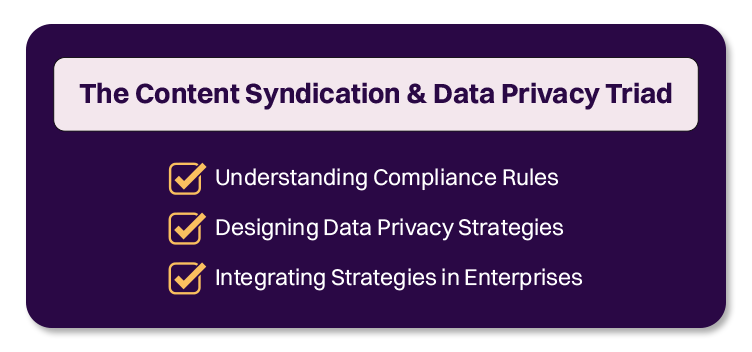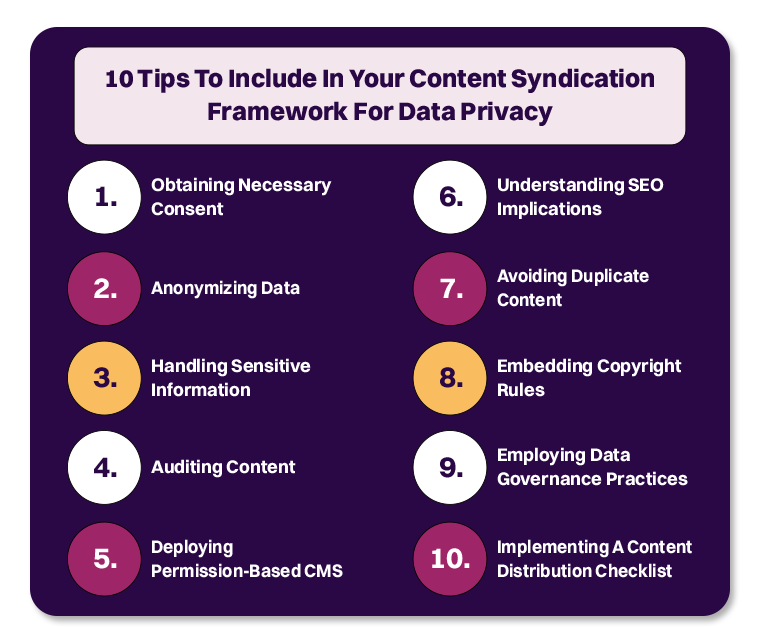
Data Privacy for Content Syndication: Go-to Guide for Marketers
As per McKinsey, 87% of customers won’t do business with a company if concerned about its security practices. Plus, 71% would cease their partnership with a firm if it gave away sensitive data without permission.
Yes, in a digital landscape, data breaches make regular headlines. As such, it’s unsurprising that your customers are concerned about their data privacy.
Therefore, ensuring your business complies with data protection regulations is not just a checkbox exercise. It's a fundamental trust-building strategy.
And this also applies to one of your key B2B marketing strategies – content syndication. So, let's explore the intricacies of content syndication concerning data privacy.
Data Privacy and Compliance Rules in Content Syndication

Let’s start by discussing the first point from the trio – understanding data privacy regulations specific to your industry:
1. GDPR (General Data Protection Regulation)
GDPR is a comprehensive data privacy regulation that applies to businesses operating within the EU or processing the personal data of EU residents. It sets strict standards for collecting, processing, and protecting personal data.
Fundamental principles include transparency, consent, and data minimization. GDPR grants your consumers greater control over their data. Plus, it requires your organization to implement safeguards to ensure data privacy.
2. CCPA (California Consumer Privacy Act)
CCPA is a data privacy regulation specific to the state of California, United States. It grants California residents certain rights regarding their personal information. These include the right to:
- Know what personal information is collected
- Request deletion of personal data
- Opt-out of the sale of personal information
CCPA will apply to your business if you handle the personal information of California residents, even if your firm is not physically located in the state.
NOTE: CCPA and GDPR are highly relevant to content syndication because they govern how personal data – including email addresses and contact information – is collected, processed, and used.
3. HIPAA (Health Insurance Portability and Accountability Act)
HIPAA is specific to the healthcare industry. However, your B2B content syndication may involve healthcare-related topics or data. Then, consider HIPAA compliance, especially when handling Protected Health Information (PHI).
4. GLBA (Gramm-Leach-Bliley Act)
If you are a B2B financial institution engaged in content syndication, you should adhere to GLBA – to safeguard consumers' financial information.
5. SOX (Sarbanes-Oxley Act)
Public companies engaging in content syndication should consider SOX compliance to ensure accurate financial reporting and data security.
6. Intellectual Property Rights
You must adequately regard copyrights, trademarks, and other intellectual property rights. Make sure to obtain the appropriate permissions or licenses when incorporating third-party material.
7. Advertising and Promotion Standards
You should verify that any statements in your content can be supported and are free from misleading information. It encompasses steering clear of deceptive advertising and unfair competitive practices.
8. Disclosure and Openness
Sometimes your syndicated content might be sponsored or involve compensation in any form. Then, it is typically a legal requirement in many jurisdictions to disclose this information.
10 Tips to Include in Your Content Syndication Framework for Data Privacy

This is a crucial step in adhering to legal requirements. Here are 10 tips to help you navigate compliance effectively:
1. Obtaining Necessary Consent
One of the foundational principles of data privacy regulations like GDPR and CCPA is obtaining explicit consent from individuals for data processing.
Ensure your syndication practices involve obtaining consent when necessary, especially when collecting and processing personal data.
2. Anonymizing Data
Encrypting sensitive information is an effective way to protect individual privacy while still benefiting from data insights. Consider anonymizing data collected through syndication to align with data protection regulations.
3. Handling Sensitive Information
Implement robust data handling procedures for sensitive information. Ensure compliance with industry-specific regulations like HIPAA when handling private or susceptible data.
4. Auditing Content
Conduct regular content audits to identify materials suitable for syndication. Look for high-quality, original content within your library that aligns with compliance requirements.
5. Deploying Permission-Based CMS
Utilize Content Management Systems (CMS) that offer granular permissions to control access. Ensure your syndicated content complies with legal requirements, including copyright regulations.
6. Understanding SEO Implications
Be aware that content syndication can impact your SEO ranking, either positively or negatively, depending on various factors. Elements like canonical and no-index tags, direct attribution links, and the accuracy of titles can influence SEO outcomes.
7. Avoiding Duplicate Content
Prevent duplicate content issues, as Google may penalize your website for it. Ensure your syndicated content is appropriately attributed and does not result in content duplication.
8. Embedding Copyright Rules
Establish clear guidelines for handling copyrighted materials during syndication. It includes obtaining necessary permissions from original creators or ensuring proper attribution.
9. Employing Data Governance Practices
Implement robust data governance practices for compliance with data privacy regulations:
- Regularly clean and standardize lead data generated from syndicated content.
- Leverage technology solutions to automate these processes, reducing the risks associated with manual data handling.
10. Implementing a Content Distribution Checklist
How can you ensure your employees distribute content accurately through the proper channels? You can achieve this by implementing a checklist incorporating your company's content syndication policies and local regulations.
Best Practices to Integrate Compliance in Your Content Syndication Approach
Now, you know the right strategies to include data privacy rules in your content syndication framework. Next, here are some best practices to ensure your team adheres to these regulations:
1. Making Compliance Integral
Remember that non-compliance with data privacy regulations can lead to severe consequences, including hefty fines and a loss of customer trust.
Therefore, make compliance an integral part of your overall business strategy. Ensure it is ingrained in your content syndication practices.
2. Holding Training Sessions
Educating employees on compliance is crucial to protect your business and customers. Hence, conducting regular in-house training classes is non-negotiable regarding compliance awareness.
Hence, host structured offline educational programs or workshops. Equip your marketing team with the knowledge and skills they need to understand and adhere to relevant regulations. Plus, encourage your employees to report any concerns they may encounter during their work.
You can also opt for online eLearning programs. Here are some methods:
A. Utilizing Learning Management Systems
Leverage Learning Management Systems (LMS) or dedicated compliance training platforms to deliver targeted, up-to-date training content. These platforms allow you to tailor training materials to your specific compliance needs.
B. Adopting a Blended Learning Approach
Combine face-to-face instruction with on-demand courses to create a blended learning approach. It accommodates different learning styles and ensures your employees have access to compliance training whenever needed.
C. Including Virtual Instructor-Led Training (VILT)
Schedule and manage VILT sessions to provide real-time interaction and guidance. Virtual training allows for a dynamic learning experience, even when employees are working remotely.
3. Having Clear Content Guidelines
Develop clear content guidelines that emphasize compliance. They should serve as a reference point for your marketing team. These must outline best practices and rules to follow when creating and distributing content.
4. Deploying Certification Programs
Consider implementing certification programs that align with your company's unique compliance requirements. They can help employees demonstrate their understanding of compliance principles and practices.
5. Cultivating a Culture of Compliance Recognition
Foster a culture within your marketing team where compliance is recognized and valued. Encourage team members to take ownership of compliance and understand its significance – in safeguarding both the organization and its customers.
6. Maintaining Documented Records
Keep accessible records of compliance checklists. It enables your team to conveniently refer to and adhere to established protocols, promoting a proactive stance towards compliance.
7. Establishing a Robust Content Agreement
Design a comprehensive content agreement. This document helps you tackle legal concerns like plagiarism. Moreover, it provides explicit directions for–
- Work parameters
- Deadlines
- Payments
- Approval procedures
8. Keeping Abreast of Regulatory Modifications
In cases of alterations or updates in relevant laws, promptly disseminate this information to the relevant teams within your organization.
9. Learning from Practical Examples
Showcase real-life case studies or instances of non-compliance, both from internal and external sources. It will enhance awareness about potential pitfalls by not following compliance rules.
Common Mistakes and Their Redressals for Content Syndication
Mistakes can happen despite rigorous measures, but having a robust response plan is key. Swiftly address non-compliance, assess its impact, rectify the issue, and implement preventive measures.
Learning from mistakes leads to continuous improvement in compliance efforts. Here’s how:
1. Insufficient Due Diligence
- Mistake: Not conducting thorough evaluations of content for compliance issues.
- Redressal: Implement a comprehensive content review procedure with legal counsel to identify and address compliance concerns effectively.
2. Lack of Transparency in Endorsement
- Mistake: Failing to disclose endorsements or sponsored content adequately.
- Redressal: Maintain transparency by clearly designating such content as endorsements or sponsored, ensuring openness with your audience.
3. Intellectual Property Rights Misunderstandings
- Mistake: Lack of understanding regarding intellectual property rights.
- Redressal: Address copyright violations through regular audits of syndicated content. Promptly remove infringing materials and reinforce guidelines for crediting original creators.
4. Data Privacy Breaches
- Mistake: Lax data governance practices leading to data privacy breaches.
- Redressal: Report data privacy breaches promptly as per regulations like GDPR. Also, improve data handling procedures with automation and stringent governance protocols to prevent future breaches.
5. Employee Knowledge Gaps
- Mistake: Non-compliance due to insufficient staff knowledge.
- Redressal: Provide refresher training or comprehensive initial training for employees. Regularly update and communicate changes in compliance standards to ensure ongoing understanding and adherence.
Conclusion
Incorporating compliance into your B2B content syndication strategy is not just a legal requirement; it's essential for ethical and trustworthy business operations. To achieve this, start by deeply understanding the key compliance rules relevant to your industry and making compliance an integral part of your strategy.
If you need more information or assistance navigating the complexities of compliance, don't hesitate to contact a reputable content syndication agency like Revnew. We're here to help you ensure compliance while achieving your syndicated marketing goals.



